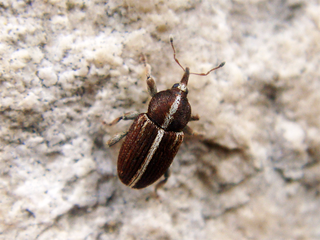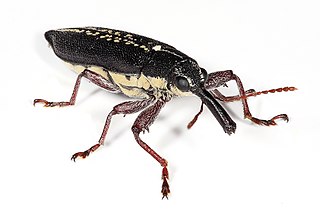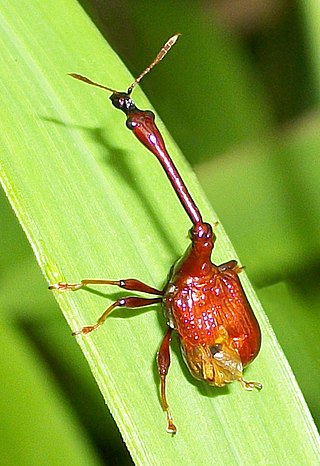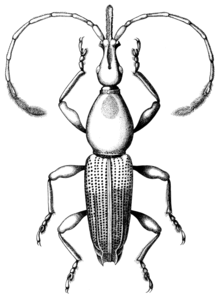
The Curculionidae are a family of weevils, commonly called snout beetles or true weevils. They are one of the largest animal families with 6,800 genera and 83,000 species described worldwide. They are the sister group to the family Brentidae.

Weevils are beetles belonging to the superfamily Curculionoidea, known for their elongated snouts. They are usually small – less than 6 mm in length – and herbivorous. Approximately 97,000 species of weevils are known. They belong to several families, with most of them in the family Curculionidae. It also includes bark beetles, which while morphologically dissimilar to other weevils in lacking the distinctive snout, is a subfamily of Curculionidae. Some other beetles, although not closely related, bear the name "weevil", such as the biscuit weevil, which belongs to the family Ptinidae.
Ambrosia beetles are beetles of the weevil subfamilies Scolytinae and Platypodinae, which live in nutritional symbiosis with ambrosia fungi. The beetles excavate tunnels in dead or stressed trees into which they introduce fungal gardens, their sole source of nutrition. After landing on a suitable tree, an ambrosia beetle excavates a tunnel in which it releases its fungal symbiont. The fungus penetrates the plant's xylem tissue, extracts nutrients from it, and concentrates the nutrients on and near the surface of the beetle gallery. Ambrosia fungi are typically poor wood degraders, and instead utilize less demanding nutrients. Symbiotic fungi produce and detoxify ethanol, which is an attractant for ambrosia beetles and likely prevents growth of antagonistic pathogens and selects for other beneficial symbionts. The majority of ambrosia beetles colonize xylem of recently dead trees, but some colonize stressed trees that are still alive, and a few species attack healthy trees. Species differ in their preference for different parts of trees, different stages of deterioration, and in the shape of their tunnels ("galleries"). However, the majority of ambrosia beetles are not specialized to any taxonomic group of hosts, unlike most phytophagous organisms including the closely related bark beetles. One species of ambrosia beetle, Austroplatypus incompertus exhibits eusociality, one of the few organisms outside of Hymenoptera and Isoptera to do so.

The New York weevil is a species of primitive weevil; large for weevils (12–18 mm), it is covered with fine bristles and has a regular pattern of light and dark spots. It occurs in the eastern United States and southern Canada.

The beetle subfamily Curculioninae is part of the weevil family Curculionidae. It contains over 23,500 described species in 2,200 genera, and is therefore the largest weevil subfamily. Given that the beetle order (Coleoptera) contains about one-quarter of all known organisms, the Curculioninae represent one of the – if not the – most successful radiations of terrestrial Metazoa.

Belidae is a family of weevils, called belids or primitive weevils because they have straight antennae, unlike the "true weevils" or Curculionidae which have geniculate (elbowed) antennae. They are sometimes known as "cycad weevils", but this properly refers to a few species from the genera Parallocorynus and Rhopalotria.

The Attelabidae is a widespread family of weevils. They are among the primitive weevils, because of their straight antennae, which are inserted near the base of the rostrum. The prothorax is much narrower than the base of the elytra on the abdomen. Attelabidae and the related family Rhynchitidae are known commonly as the leaf-rolling weevils. Rhynchitidae may be treated as subfamily Rhynchitinae of the Attelabidae.

The New Zealand giraffe weevil, Lasiorhynchus barbicornis, is a straight-snouted weevil in the subfamily Brentinae, endemic to New Zealand. L. barbicornis is New Zealand's longest beetle, and shows extreme sexual dimorphism: males measure up to 90mm, and females 50mm, although there is an extreme range of body sizes in both sexes. In males, the elongated snout can be nearly as long as the body. Male giraffe weevils use this long rostrum to battle over females, although small males can avoid conflict and 'sneak' in to mate with females, sometimes under the noses of large males. The larval weevils tunnel into wood for at least two years before emerging, and live for only a few weeks as adults.

Nemonychidae is a small family of weevils, placed within the primitive weevil group because they have straight rather than geniculate (elbowed) antennae. They are often called pine flower weevils. As in the Anthribidae, the labrum appears as a separate segment to the clypeus, and the maxillary palps are long and projecting. Nemonychidae have all ventrites free, while Anthribidae have ventrites 1-4 connate or partially fused. Nemonychidae lack lateral carinae on the pronotum, while these are usually present, though may be short, in Anthribidae.

Oxycoryninae are subfamily of primitive weevils of the family Belidae, but sometimes treated as a distinct family Oxycorynidae. Like in other belids, their antennae are straight, not elbowed as in the true weevils (Curculionidae), and their larvae feed on the wood of diseased or dying plants or on deadwood or fruits; they tend to avoid healthy plants.

Belinae are a Gondwanan subfamily of beetles which belong to the belids, primitive weevils of the family Belidae. Like in other belids, their antennae are straight, not elbowed as in the true weevils (Curculionidae). The Belinae make up the bulk of the diversity of living belid genera. They are found in the Australia-New Guinea-New Zealand and South America.

Aglycyderini is a tribe of belids, primitive weevils of the family Belidae. Like in other belids, their antennae are straight, not elbowed as in the true weevils (Curculionidae). They occur only on the Pacific Islands and in the Macaronesian region.
Metrioxenini (metrioxenines) are a tribe of belids, primitive weevils of the family Belidae, containing about 30 species. They are only found in two widely separated areas, Southeast Asia extending to Indonesia, and South Africa. In the Paleogene, they were found at least in North America and Europe also, occurring perhaps across the entire Northern Hemisphere.

Oxycorynini are a tribe of American belids, primitive weevils of the family Belidae. Like in other belids, their antennae are straight, not elbowed as in the true weevils (Curculionidae). In contrast to other Belidae, Oxycorynini larvae feed on flowers or several types of fruit.

The Entiminae are a large subfamily in the weevil family Curculionidae, containing most of the short-nosed weevils, including such genera as Entimus, Otiorhynchus, Phyllobius, Sitona, and Pachyrrhynchus. In comparison with their stunning diversity, only a few of these weevils are notorious pests of major economic importance. Entimines are commonly encountered in the field, including urban environments, and abundant in entomological collections.
Trachelizinae is a subfamily of primitive weevils in the family of beetles known as Brentidae. There are at least 110 genera and 710 described species in Trachelizinae.

Cyladinae is a subfamily of sweet potato weevils in the family of beetles known as Brentidae. There are two genera in Cyladinae, Cylas Latreille 1802, and the extinct genus Miocenocylas Legalov 2018.

Brentinae is a subfamily of primitive weevils in the family of beetles known as Brentidae. There are at least 90 genera and 520 described species in Brentinae.

Cyphagoginae is a subfamily of primitive weevils in the family of beetles known as Brentidae. There are at least 70 genera and 420 described species in Cyphagoginae. Cyphagoginae is sometimes treated as the tribe Cyphagogini rather than a subfamily, according to Oberprieler, 2007.

Mesophyletidae is an extinct family of weevils known from a number of genera preserved in Cretaceous amber. The family was first described as a subfamily in the extant family Caridae, and subsequently raised to family status in 2018.


















